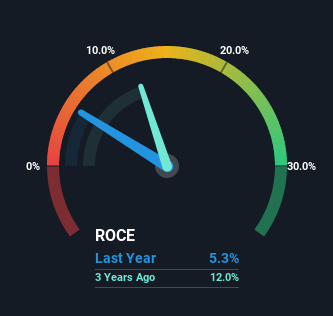- United Kingdom
- /
- Consumer Durables
- /
- AIM:AIEA
AIREA (LON:AIEA) Has Some Difficulty Using Its Capital Effectively
If we're looking to avoid a business that is in decline, what are the trends that can warn us ahead of time? Businesses in decline often have two underlying trends, firstly, a declining return on capital employed (ROCE) and a declining base of capital employed. This indicates to us that the business is not only shrinking the size of its net assets, but its returns are falling as well. So after we looked into AIREA (LON:AIEA), the trends above didn't look too great.
Understanding Return On Capital Employed (ROCE)
For those who don't know, ROCE is a measure of a company's yearly pre-tax profit (its return), relative to the capital employed in the business. To calculate this metric for AIREA, this is the formula:
Return on Capital Employed = Earnings Before Interest and Tax (EBIT) ÷ (Total Assets - Current Liabilities)
0.053 = UK£1.1m ÷ (UK£25m - UK£4.7m) (Based on the trailing twelve months to June 2022).
So, AIREA has an ROCE of 5.3%. Ultimately, that's a low return and it under-performs the Consumer Durables industry average of 14%.
See our latest analysis for AIREA

Historical performance is a great place to start when researching a stock so above you can see the gauge for AIREA's ROCE against it's prior returns. If you're interested in investigating AIREA's past further, check out this free graph of past earnings, revenue and cash flow.
What Does the ROCE Trend For AIREA Tell Us?
In terms of AIREA's historical ROCE movements, the trend doesn't inspire confidence. About five years ago, returns on capital were 6.7%, however they're now substantially lower than that as we saw above. And on the capital employed front, the business is utilizing roughly the same amount of capital as it was back then. Companies that exhibit these attributes tend to not be shrinking, but they can be mature and facing pressure on their margins from competition. So because these trends aren't typically conducive to creating a multi-bagger, we wouldn't hold our breath on AIREA becoming one if things continue as they have.
The Key Takeaway
All in all, the lower returns from the same amount of capital employed aren't exactly signs of a compounding machine. Despite the concerning underlying trends, the stock has actually gained 16% over the last five years, so it might be that the investors are expecting the trends to reverse. Regardless, we don't like the trends as they are and if they persist, we think you might find better investments elsewhere.
On a final note, we found 3 warning signs for AIREA (1 is concerning) you should be aware of.
While AIREA isn't earning the highest return, check out this free list of companies that are earning high returns on equity with solid balance sheets.
New: Manage All Your Stock Portfolios in One Place
We've created the ultimate portfolio companion for stock investors, and it's free.
• Connect an unlimited number of Portfolios and see your total in one currency
• Be alerted to new Warning Signs or Risks via email or mobile
• Track the Fair Value of your stocks
Have feedback on this article? Concerned about the content? Get in touch with us directly. Alternatively, email editorial-team (at) simplywallst.com.
This article by Simply Wall St is general in nature. We provide commentary based on historical data and analyst forecasts only using an unbiased methodology and our articles are not intended to be financial advice. It does not constitute a recommendation to buy or sell any stock, and does not take account of your objectives, or your financial situation. We aim to bring you long-term focused analysis driven by fundamental data. Note that our analysis may not factor in the latest price-sensitive company announcements or qualitative material. Simply Wall St has no position in any stocks mentioned.
About AIM:AIEA
AIREA
Designs, manufactures, and sells floor coverings in the United Kingdom and internationally.
Flawless balance sheet and fair value.
Market Insights
Community Narratives



